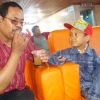Introduction
Indonesia, just like Poland, had been colonized by at least 5 (five) countries and now is still processing to select its identity of nation, or as former Indonesian Ambassador for Czech Republic, Prof. Salim Said, ever said that Indonesia is still identified as an unfinished nation. In this unfinished nation problem, Indonesia has some third world problems, including the management system of defence heritage, not just the tangible one, but also the intangible.
Indonesia is one of 161 countries, who participated and ratified UN General Assembly meeting proposed by UNESCO to define an international instrumental binding law to do protection of intangible heritage. The Convention statement of UNESCO said that (Dachlan, 2015, p.132):
"Measures aimed at ensuring the viability of the intangible cultural heritage, including the identification, documentation, research, preservation, protection, promotion, enhancement, transmission, particularly through formal and non-formal education, as well as the revitalization of the various aspects of such heritage".
Dachlan (2015, p.132) also said that long before that Convention that stated the digitalization of heritage, being stated by UNESCO, Indonesia government, under Ministry of Tourism already had digitalization of cultural heritage, with the categories as follows:
- Alat Musik (lit. "musical instrument"), 600 elements;
- Cerita Rakyat (lit. "folktale"), 495 elements;
- Makanan Minuman (food and beverages), 1897 elements;
- Motif Kain (lit. "clothing motive"), 665 elements;
- Musik dan Lagu (lit. 'music and song'), 531 elements;
- Naskah Kuno dan Prasasti (lit. "ancient scripture and inscription"), 121 elements;
- Ornamen (lit. "ornament"), 350 elements;
- Pakaian Tradisional (lit. "traditional clothing"), 190 elements;
- Permainan Tradisional (lit. "traditional game"), 189 elements;
- Produk Arsitektur (lit. "architectural product"), 479 elements;
- Ritual (lit. "rite"), 447 elements;
- Seni Pertunjukan (lit. "performance art"), 250 elements;
- Senjata dan Alat Perang (lit. "weapons and war equipment"), 150 elements;
- Tarian (lit. "dance"), 679 elements; and
- Tata Cara Pengobatan dan Pemeliharaan Kesehatan (lit. "medical and healthcare procedure"), 38 elements.
Indonesia also ratify Article 2 Year 2013 of International Convention for the Safeguarding of the Intangible Heritage, this new class of heritage (Collins, 2012, p.428):
"means the practices, representations, expressions, knowledge, skills---as well as the instruments, objects, artefacts and cultural spaces associated therewith---that communities,groups and,in some cases,individuals recognize as part of their cultural heritage. This intangible cultural heritage, transmitted from generation to generation, is constantly recreated by communities and groups in response to their environment, their interaction with nature and their history, and provides them with a sense of identity and continuity, thus promoting respect for cultural diversity and human creativity".
Method
In line with Plato, French sociologist, Alain Touraine, in his book Critique de la Modernit, has been criticizing the concept of modernism while people is too much using the Internet by abandoning the values of being real and being honest. Also, he criticizes the Human Rights as a tool of human liberty without boundaries, while in morality, the respect itself depends on the social and political context, so it is a need to not to generalize Human Rights in close-minded perspectives just to find justification of wrong values.
The theory of modernity will be used in this paper, to explain that in this modern era, Indonesian government needs to use modern technology in terms of preservation and management of defence heritage. Preservation here as the part of national interest, because it becomes the identity of the nation, that would come up each time other people seeing Indonesians, or what Indonesian diaspora represent for. Cultural heritage is not just an observation, or tourism, but also identity without boundaries, that belong to Indonesian identity to enrichen the history of nation-state itself.
The second theory used in this paper is historiography by March Bloch. On politics between 1917 and 1919, Bloch employs the notion of non-simultaneity to explain how responsibility for the outbreak of World War I cannot be ascribed solely to the imperialistic strivings of capitalism but must also be sought in the non-simultaneous cultural formations and anachronistic social ideals specific to the central powers, such as Prussian militarism and Austrian clericalism (Durst, 2002, 172).











